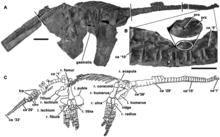Eoplesiosaurus
|
Eoplesiosaurus Temporal range: Early Jurassic, 199.6–198 Ma |
|
|---|---|
 |
|
| Holotype of Eoplesiosaurus antiquior | |
| Scientific classification | |
| Kingdom: | Animalia |
| Phylum: | Chordata |
| Class: | Reptilia |
| Superorder: | †Sauropterygia |
| Order: | †Plesiosauria |
| Superfamily: | †Plesiosauroidea |
| Genus: |
†Eoplesiosaurus Benson, Evans & Druckenmiller, 2012 |
| Type species | |
|
†Eoplesiosaurus antiquior Benson, Evans & Druckenmiller, 2012 |
|
Eoplesiosaurus is an extinct genus of basal plesiosauroid known from the Early Jurassic period (most likely earliest Hettangian stage) of the United Kingdom. It contains a single species, E. antiquior.
Eoplesiosaurus is known only from the holotype specimen TTNCM 8348, a complete and articulated postcranial skeleton. It preserved three-dimensionally with some gastralia presented. It was collected at Watchet, of Somerset, from the Pre-Planorbis beds of the Blue Lias Formation of the Lower Lias Group. These beds likely occur below the first occurrence of the ammonite Psiloceras planorbis. Thus, they probably fall within the earliest Hettangian P. tilmanni Chronozone, which is about 199.6-198 million years old, immediately following the Triassic–Jurassic Boundary. Plesiosaurs fossils which were discovered at Street (e.g. Avalonnectes and Thalassiodracon), or at penecontemporaneous strata such as the Watchet locality, represent the earliest known occurrence of the Plesiosauria. Hence, Eoplesiosaurus is the oldest plesiosauroid and one of the oldest plesiosaurs, to date.
...
Wikipedia
